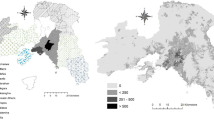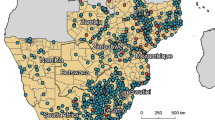Abstract
Urban patterns have shown that shifts in the social, economic, and geographical features of an area result in metropolitan growth, planned or otherwise. Rapid urbanization takes a toll on the ecological makeup of the environment and the wellbeing of humans at multiple levels. Thus, this study was drafted to quantify urban growth rates, types, and changes, with regards to urbanization patterns from 1990 to 2020. It tries to evaluate whether Addis Ababa’s urban expansion conforms to the diffusion-coalescence theory using remote sensing data. The Spatio-temporal pattern and changing aspects of the built-up land were examined using urban growth types, spatial metrics, and a gradient method. The last decade evidenced the most pronounced growth within a buffer distance of 10 to 22 km from the city center. Edge expansion was the most dominant form of growth across all three decades with more than 61% of new development each. Infill and outlying growth showed decadal variability with an alternating dominance. The Spatio-temporal investigation confirmed that the urban class and growth types remained consistent. The team concluded that diffusion and coalescence are two simultaneously occurring phases of urban growth rather than two dichotomous successive phases. Spatio-temporal patterns and the dynamic behavior of spatial metrics are instrumental in comprehending the urban growth process and cycle. Moreover, the results can aid in assessing the land use planning policy as well as to guide future land use planning.










Similar content being viewed by others
Availability of data and material
The datasets used and/or analyzed during the current study are available from the corresponding author on reasonable request.
References
UN (2012) World urbanization prospects: the 2011 revision. Retrieved from http://esa.un.org/unup/CD-ROM/Urban-Rural-Population.html
Coskun, H. G., Alganci, U., & Usta, G. (2008). Analysis of land use change and urbanization in the Kucukcekmece water basin (Istanbul, Turkey) with temporal satellite data using remote sensing and GIS. Sensors, 8, 7213–7223.
Angel S, Parent J, Civco D (2007) Urban sprawl metrics: an analysis of global urban expansion using GIS Introduction: The attributes and manifestations of urban “sprawl”. In: ASPRS 2007 annual conference, pp 1–12
Martinuzzi, S., Gould, W. A., & Ramos González, O. M. (2007). Land development, land use, and urban sprawl in Puerto Rico integrating remote sensing and population census data. Landscape and Urban Planning, 79(3–4), 288–297.
Jiang, F., Liu, S., Yuan, H., & Zhang, Q. (2007). Measuring urban sprawl in Beijing with geo-spatial indices. Journal of Geographical Sciences, 17(4), 469–478.
Bhatta, B., Saraswati, S., & Bandyopadhyay, D. (2010). Quantifying the degree-of-freedom, degree-of-sprawl, and degree-of-goodness of urban growth from remote sensing data. Applied Geography, 30(1), 96–111.
Xu, X., & Min, X. (2013). Quantifying spatiotemporal patterns of urban expansion in China using remote sensing data. Cities, 35, 104–113.
Rashed, T. (2008). Remote sensing of within class change in urban neighborhood structures. Computers, Environment & Urban Systems, 32(2008), 343–354.
Jensen, J., & Lulla, K. (1987). Introductory digital image processing: a remote sensing perspective. New Jersey: Pearson Prentice Hall.
Batisani, N., & Yarnal, B. (2009). Urban expansion in Centre County, Pennsylvania: Spatial dynamics and landscape transformations. Applied Geography, 29(2), 235–249.
Mas, J.-F., Gao, Y., & Pacheco, J. A. N. (2010). Sensitivity of landscape pattern metrics to classification approaches. Forest Ecology & Management, 259(2010), 1215–1224.
Saura, S., & Castro, S. (2007). Scaling functions for landscape pattern metrics derived from remotely sensed data: Are their subpixel estimates really accurate? ISPRS Journal of Photogrammetry & Remote Sensing, 62(2007), 2010–2216.
Herold, M., Couclelis, H., & Clarke, K. C. (2005). The role of spatial metrics in the analysis and modeling of urban land use change. Computers, Environment & Urban Systems, 29(2005), 369–399.
Mundia, C. N., & Aniya, M. (2005). Analysis of land use/cover changes and urban expansion of Nairobi city using remote sensing and GIS. International Journal of Remote Sensing, 26(13), 2831–2849.
Herold, M., Goldstein, N. C., & Clarke, K. C. (2003). The spatiotemporal form of urban growth: Measurement, analysis and modeling. Remote Sensing of Environment, 86(3), 286–302.
Sudhira, H. S., Ramachandra, T. V., & Jagadish, K. S. (2004). Urban sprawl: Metrics, dynamics and modelling using GIS. International Journal of Applied Earth Observation and Geoinformation, 5(1), 29–39.
Burgess, E. W. (1925). The growth of the city: An introduction to a research project. Chicago: Chicago Press.
Portugali, J. (2000). Self-organization and the city. Berlin: Springer.
Dietzel, C., Herold, M., Hemphill, J. J., & Clarke, K. C. (2005). Spatiotemporal dynamics in California’s Central Valley: Empirical links to urban theory. International Journal of Geographical Information Science, 19(2), 175–195.
Shukla, A., & Jain, K. (2019). Critical analysis of spatial-temporal morphological characteristic of urban landscape. Arabian Journal of Geosciences , 12, 112.
Fang, C., & Zhao, S. (2018). A comparative study of spatiotemporal patterns of urban expansion in six major cities of the Yangtze River Delta from 1980 to 2015. Ecosystem Health and Sustainability, 4, 95–114.
Luck, M., & Wu, J. G. (2002). A gradient analysis of urban landscape pattern: A case study from the Phoenix metropolitan region, Arizona, USA. Landscape Ecology, 17(4), 327–339.
Deng, J., Wang, K., Hong, Y., & Qi, J. (2009). Spatio-temporal dynamics and evolution of land use change and landscape pattern in response to rapid urbanization. Landscape Urban Planning, 92(3–4), 187–198.
Tadesse, W., Tsegaye, T., Coleman, T. (2001). Land use/cover change detection of the city of Addis Ababa, Ethiopia using remote sensing and geographic information system technology. In Paper presented at the geoscience and remote sensing symposium.
Fetene, A., & Worku, H. (2013). Planning for the conservation and sustainable use of urban forestry in Addis Ababa, Ethiopia. Urban Forestry & urban Greening, 12, 367–379.
Woldegerima, T., Yeshitela, K., & Lindley, S. (2016). Characterizing the urban environment through urban morphology types (UMTs) mapping and land surface cover analysis: The case of Addis Ababa, Ethiopia. Urban Ecosystem, 20, 245–263.
Central Statistical Authority (CSA). Census-2007 Report. Retrieved July 22, 2020 from http://www.csa.gov.et/censusreport/complete-report/census-2007#.
AABoFED. (2010). Addis Ababa city government urban development indicators. Finance and Economic Development Bureau. Addis Ababa. Unpublished Technical Report, Addis Ababa, Ethiopia.
Chander, G., & Markham, B. (2003). Revised Landsat-5 TM radiometrie calibration procedures and postcalibration dynamic ranges. IEEE Transactions on Geoscience and Remote Sensing, 41(11), 2674–2677.
Anderson, J. R., Hardy, E. E., Roach, J. T., & Witmer, R. E. (1976). A land use and land cover classification system for use with Remote Sensor data. In USGS professional paper 964 (pp. 138–145). Reston, Virginia: U.S. Geological Survey.
Lillesand, T., Kiefer, R. W., & Chipman, J. (2014). Remote sensing and image interpretation. New Delhi: Wiley.
Rousta, I., Sarif, M. O., Gupta, R. D., Olafsson, H., Ranagalage, M., Murayama, Y., et al. (2018). Spatiotemporal analysis of land use/land cover and its effects on surface urban heat Island using landsat data: A case study of Metropolitan City Tehran (1988–2018). Sustainability (Switzerland), 10(12), 4433.
Foody, G. M. (2002). Status of land cover classification accuracy assessment. Remote Sensing of Environment, 80(1), 185–201.
Liu, X., Li, X., Chen, Y., Tan, Z., Li, S., & Ai, B. (2010). A new landscape index for quantifying urban expansion using multi-temporal remotely sensed data. Landscape Ecology, 25(5), 671–682.
Harrison, S. (1999). Local and regional diversity in a patchy landscape: Native, alien, and endemic herbs on serpentine. Ecology, 80(1), 70–80.
McGarigal, K., & Marks, B. J. (1995). FRAGSTATS: Spatial pattern analysis program for quantifying landscape structure, USDA Forest Service, p. 122. NBSC (2012). China’s city construction statistical yearbook of 2011. China Statistics Press.
Jenerette, G. D., & Potere, D. (2010). Global analysis and simulation of land-use change associated with urbanization. Landscape Ecology, 25(5), 657–670.
Zhao, J., Zhu, C., & Zhao, S. (2012). Comparing the spatiotemporal dynamics of urbanization in moderately developed Chinese Cities over the past three decades: Case of Nanjing and Xi’an. Journal of Urban Planning and Development. https://doi.org/10.1061/(ASCE)UP.
Tian, G., Jiang, J., Yang, Z., et al. (2011). The urban growth, size distribution and spatio-temporal dynamic pattern of the Yangtze River megalopolitan region, China. Ecological Modelling, 222(3), 865–878.
Aina, Y. A., Adam, E., Ahmed, F., Wafer, A., & Alshuwaikhat, H. M. (2019). Using multisource data and the VIS model in assessing the urban expansion of Riyadh city, Saudi Arabia. European Journal of Remote Sensing, 52(1), 557–571.
Dahal, K. R., Benner, S., & Lindquist, E. (2016). Analyzing spatiotemporal patterns of urbanization in Treasure Valley, Idaho, USA. Applied Spatial Analysis and Policy, 11(2), 205–226.
Li, C., Li, J., & Wu, J. (2013). Quantifying the speed, growth modes, and landscape pattern changes of urbanization: A hierarchical patch dynamics approach. Landscape Ecology, 28, 1875–1888.
Lindenmayer, D., Cunningham, R., & Pope, M. (1999). A large-scale “experiment” to examine the effects of landscape context and habitat fragmentation on mammals. Biological Conservation., 88(3), 387–403.
Zewdie, M., Worku, H., & Bantider, A. (2017). Temporal dynamics of the driving factors of urban landscape change of Addis Ababa during the past three decades. Environmental Management. https://doi.org/10.1007/s00267-017-0953-x.
Central Statistical Authority (CSA). (1999). Statistical Report on the 1999 National Labour Force Survey, March 1999, Statistical Bulletin 225. Central Statistical Agency, Addis Ababa.
Li, X., & Yeh, A. (2004). Analyzing spatial restructuring of land use patterns in a fast-growing region using remote sensing and GIS. Landscape Urban Planning, 69(4), 335–354.
Hailemariam, A., & Adugna, A. (2011). Migration and urbanization in Ethiopia: addressing the spatial imbalance. In C. Teller & A. Hailemariam (Eds.), The demographic transition and development in Africa (pp. 145–165). Dordrecht: Springer.
Ministry of Urban Development Housing and Construction (MUDHCo). National Report on Housing on Housing and Sustainable Urban Development. (2014). Retrieved June 10, 2020 from https://unhabitat.org/wp-content/uploads/2014/07/Ethiopia-National-Report.pdf.
Acknowledgements
We would like to express our gratitude to our anonymous reviewers and our editor. Without their genuine and insightful comments, our research would not be as well developed. We are also thankful to United States Geological Survey (USGS) for giving online access to their Landsat data.
Funding
No funding was received.
Author information
Authors and Affiliations
Corresponding author
Ethics declarations
Conflict of interest
The authors declare that they have no conflict of interest.
Consent for publication
We have agreed to submit and approved the manuscript for submission.
Additional information
Publisher's Note
Springer Nature remains neutral with regard to jurisdictional claims in published maps and institutional affiliations.
Supplementary information
Below is the link to the supplementary information.
Rights and permissions
About this article
Cite this article
Busho, S.W., Wendimagegn, G.T. & Muleta, A.T. Quantifying spatial patterns of urbanization: growth types, rates, and changes in Addis Ababa City from 1990 to 2020. Spat. Inf. Res. 29, 699–713 (2021). https://doi.org/10.1007/s41324-021-00388-4
Received:
Revised:
Accepted:
Published:
Issue Date:
DOI: https://doi.org/10.1007/s41324-021-00388-4




